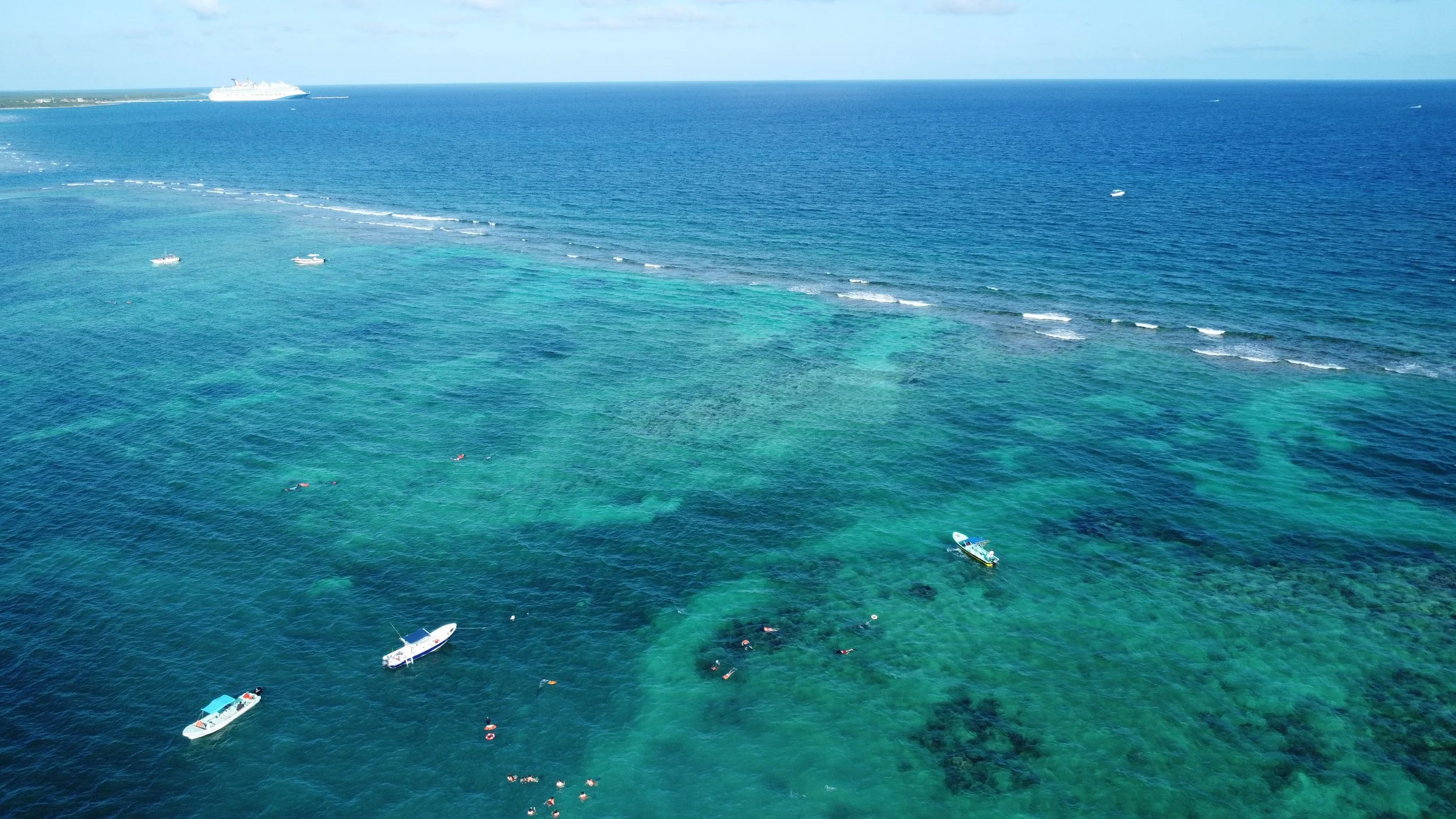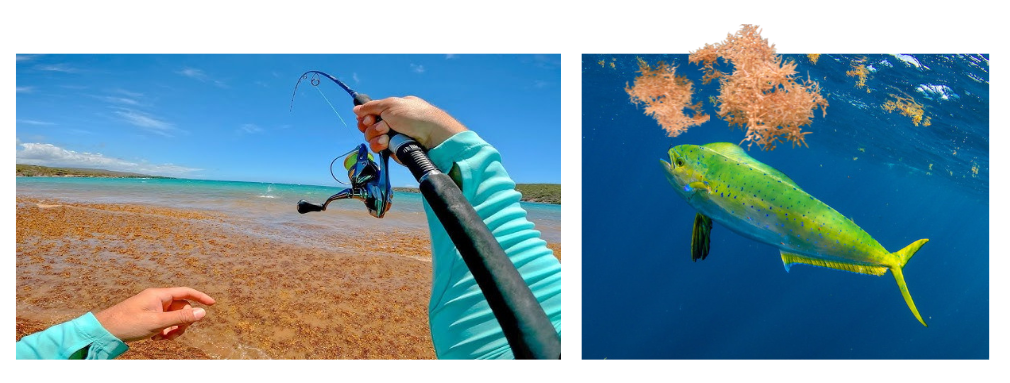Sargassum and Snorkeling in the Caribbean Sea
What you need to know to about sargassum to enjoy your trip to Mahahual, Costa Maya
Sargassum spreads throughout the sea without regulations or permission, floating from the open ocean to the shores of the Mexican Caribbean. Charles Darwin even wrote about it, so it isn’t a new phenomenon, however it can affect the comfort of your next snorkeling or beach trip to the Caribbean.
But with the right information, you can absolutely enjoy your vacation without sargassum ruining your plans!
In this guide we'll tell you what it is, how it can affect you, and what activities you can still do in Mahahual even when there’s sargassum!
What is Sargassum?
Sargassum (sargazo en español) is a floating seaweed that travels across the ocean pushed by currents and wind. Although there are many species, Sargassum natans and Sargassum fluitans are primarily seen on the Yucatán Peninsula.
Sargassum also reproduces rapidly (some doubling their biomass in less than a month) and can cover vast areas in a short time.
Ocean waters polluted with nitrogen (overwhelmingly caused by runoff from crop and livestock farms in Central and South America [citation 1]) and warming ocean temperatures are two leading causes of massive blooms (patches of sargassum) in the last decade.
Is there a good side to this macroalgae?
Although often annoying, sargassum is a necessary home and transportation for many marine species.
Crabs, shrimp, sea turtles, and young fish travel in and underneath it. Some fish, such as mahi-mahi (dorado) and species of mackerel, seek it out to find food and shelter.
Sea turtle hatchlings often use it for refuge, drifting the oceans until large enough to survive out in the open waters.
So, does sargassum play a beneficial role in the larger marine ecosystem? Absolutely.
The NOT so good side
When sargassum reaches the coast in large quantities and begins to decompose, it generates gases such as hydrogen sulfide and ammonia which negatively affect human health if inhaled excessively.
Rotting sargassum also consumes a lot of oxygen from the water, leading to hypoxic (low oxygen) or even anoxic (no oxygen) conditions [citation 2]. Unfortunately this can cause massive die-offs of countless marine species, from fish, eels, octopus, crustaceans and others.
Small, 2-inch sardines washed ashore in Mahahual in September, 2025.
Decomposing sargassum can also contaminate the water with heavy metals, trash, and microplastics, creating ideal conditions for viruses and bacteria. Therefore, effective containment and management processes are crucially important.
Does sargassum affect ecosystems?
Yes. Sargassum blocks sunlight, preventing seagrass from photosynthesizing. When decomposing it reduces oxygen levels in the water, affecting corals, fish, and other animals.
It can also bring invasive species or pathogens that disrupt the natural balance of the area's ecosystems. A study in Puerto Morelos found 32 species associated with sargassum, and 10 were new to the area!
Control and Management Strategies
• Collection in the open ocean with specialized watercraft
• Sargassum barriers preventing arrival to shorelines
• Teams of people collecting it daily from beaches/shorelines
All of this works best if done in a timely manner, taking into account the weather, tides, and currents. Otherwise, sargassum lends its detrimental effects to seagrass beds (sea our article on its importance here) and coral reefs, which are incredibly sensitive ecosystems.
What’s it like in Mahahual, Costa Maya?
Despite the sargassum, Mahahual has many clean beaches thanks to local efforts. From Krazy Lobster to La Leyenda ECO TOURS to Sulumar, you can enjoy a clean Caribbean sea, delicious food at the restaurants and beach clubs, and other activities like paddleboarding and kayaking.
Can I go snorkeling? Of course!
Once sargassum makes its way to the shore, it stays there until being collected. This means our snorkeling sites in the deeper reef lagoon and other areas in Mahahual are relatively clear of large patches.
At La Leyenda ECO TOURS we always make the effort to bring you to the most comfortable and rewarding areas of the coral reef. This means better visibility and the lowest percentage of sargassum.
What other activities are available?
Enjoy a walk down the seaside boardwalk
Relax at one of many beach clubs
Explore Mayan ruins of Chacchoben
Take a day trip to the lagoon in Bacalar
Deep Sea/Sport fishing Charters
Sargassum weedlines in the open sea can be a great spot for finding big fish such as mahi-mahi. Experienced anglers know how to take advantage of them, and all you have to do is enjoy the experience. (Check out our fishing charters/packages here!)
Come visit us in Mahahual!
Although sargassum does appear year after year, Mahahual offers incredible scenery both at sea and on land. You can also contact us to set up a day trip to visit the beautiful lagoon at Bacalar, or take a walk through the jungle while exploring the ancient mayan ruins of Chacchoben.
The key to a successful trip to the Caribbean is to be prepared, a bit flexible, and to take advantage of every moment. In the end, the best vacations are those enjoyed with a sense of purpose and a desire to explore.
Citations
1 Madeline Berger, Steven W.J. Canty, Cascade Tuholske, Benjamin S. Halpern,
Sources and discharge of nitrogen pollution from agriculture and wastewater in the Mesoamerican Reef region,
Ocean & Coastal Management, Volume 227, 2022, 106269, ISSN 0964-5691, https://doi.org/10.1016/j.ocecoaman.2022.106269.
(https://www.sciencedirect.com/science/article/pii/S0964569122002459)
2 https://www.epa.gov/habs/basic-information-sargassum









